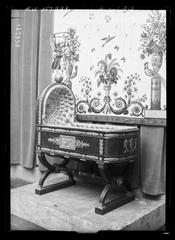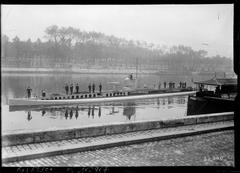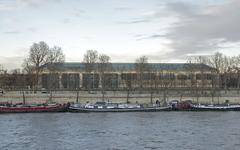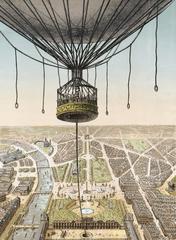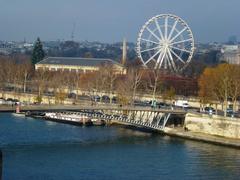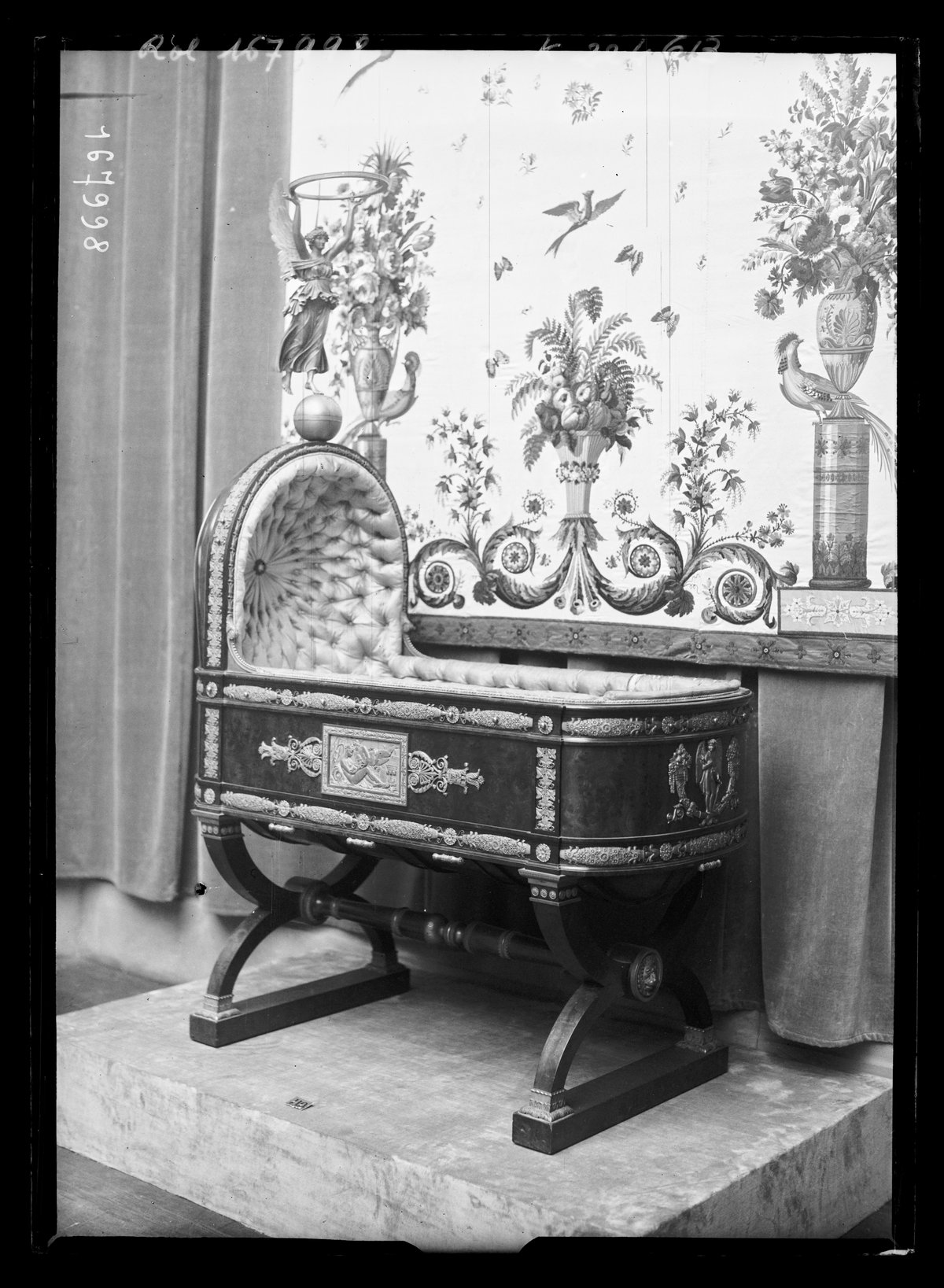
Musée de l’Orangerie Visiting Hours, Tickets, and Paris Historical Sites Guide
Date: 14/06/2025
Introduction
Located in the heart of the Tuileries Garden, the Musée de l’Orangerie is a Parisian gem renowned for its exceptional Impressionist and Post-Impressionist art collections—most notably Claude Monet’s monumental “Water Lilies” murals. This institution seamlessly blends artistic innovation with a rich historical legacy, offering visitors an immersive and contemplative experience. Originally constructed in 1852 to house citrus trees for Emperor Napoleon III, the Orangerie transitioned into an art museum in the early 20th century. It now stands as a testament to Paris’s dynamic artistic and architectural heritage, attracting art lovers and cultural travelers from around the world (Discover Walks; Museos.com).
This comprehensive guide details everything you need to know for your visit: history, highlights, ticketing, accessibility, travel tips, nearby attractions, and essential FAQs. Whether you are an art enthusiast or a first-time visitor exploring Paris’s historical wonders, this resource will help you plan an unforgettable experience at the Musée de l’Orangerie (Musée de l’Orangerie Official Website).
Table of Contents
- Introduction
- Historical Overview
- Origins as an Orangery (1852–1921)
- Transformation into a Museum (1921–1927)
- The Monet Water Lilies: A National Treasure
- Expansion and the Walter-Guillaume Collection
- Role in French Cultural Life and Exhibitions
- Renovations and Modernization
- Present-Day Status and Popular Culture
- Architectural and Experiential Highlights
- Visiting Information
- FAQs
- Plan Your Visit
- Summary and Call to Action
- References
Historical Overview
Origins as an Orangery (1852–1921)
The building now known as the Musée de l’Orangerie was commissioned by Napoleon III in 1852 as a winter shelter for the orange trees of the Tuileries Garden. Architect Firmin Bourgeois designed the structure to maximize sunlight on the south side with glass and protect against cold winds on the north with solid walls, integrating functionality with elegance (Discover Walks; Come to Paris). Over the years, the Orangerie also hosted public events and exhibitions, especially after the destruction of the Tuileries Palace in 1871.
Transformation into a Museum (1921–1927)
In 1921, the Orangerie was officially transferred to the Under-Secretariat of State for Fine Arts to serve as a venue for contemporary art. Following modifications, it opened as a museum in 1927. A landmark moment was Claude Monet’s donation of his Water Lilies murals, with the stipulation that they be displayed in a space designed to his specifications—resulting in the now-iconic oval rooms filled with natural light (Wander Your Way; Paris Evous).
The Monet Water Lilies: A National Treasure
Monet’s immersive Water Lilies cycle, installed between 1914 and 1926, remains the centerpiece of the Orangerie. Designed as “the illusion of an endless whole,” the eight monumental panels encircle visitors in two oval rooms, creating a meditative sanctuary of light, water, and reflection (Paris Evous; Wander Your Way).
Expansion and the Walter-Guillaume Collection (1959–1963)
The museum’s prestige was further elevated by the addition of the Jean Walter and Paul Guillaume Collection, encompassing 144 works by masters such as Cézanne, Renoir, Matisse, Picasso, Modigliani, and Soutine (Wikipedia). This collection bridges Impressionism and early modernism, offering a comprehensive survey of European art from the late 19th to early 20th centuries.
Role in French Cultural Life and Temporary Exhibitions
Since the 1930s, the Orangerie has been a premier venue for major art exhibitions, retrospectives, and the display of recovered masterpieces. Its “Contrepoint contemporain” program showcases modern and contemporary art alongside its permanent collections (Wikipedia; Paris Evous).
Renovations and Modernization (2000–2006)
A major renovation from 2000 to 2006 restored Monet’s Water Lilies rooms to their original luminous state, created underground galleries for the Walter-Guillaume Collection, and improved accessibility with new amenities. The museum reopened in 2006 with enhanced facilities for exhibitions, learning, and events (Wikipedia).
Present-Day Status and Popular Culture
Today, the Musée de l’Orangerie operates in partnership with the Musée d’Orsay and welcomes hundreds of thousands of visitors annually. The museum also features in popular films and games, underscoring its symbolic status in Parisian and artistic culture (Wikipedia).
Architectural and Experiential Highlights
The oval Water Lilies rooms, designed in harmony with Monet’s vision, offer a unique contemplative environment. The museum’s compact size and serene setting within the Tuileries Garden make it ideal for focused and meaningful engagement with art (Wander Your Way).
Visiting Information
Visiting Hours and Days Open
- Open: Tuesday to Sunday, 9:00 a.m. – 6:00 p.m.
- Closed: Mondays, May 1st, mornings of July 14th, and December 25th
- Last Admission: 5:15 p.m. (gallery evacuation from 5:45 p.m.)
(Get Paris Tours)
Ticket Prices and Where to Buy Tickets
- Standard Ticket: €12–€12.50
- Reduced Rate: €10 (students, seniors, and eligible categories)
- Free Admission: Under 18s, EU residents under 26, and the first Sunday of every month
- Combo Tickets: Available for Musée d’Orsay and Seine cruises
- Annual Pass: Unlimited museum access with the “Carte Blanche”
- Booking: Advance online booking is strongly recommended, especially in peak season. Mobile tickets are accepted. Timed entry is enforced (The Tour Guy).
Official Online Tickets
Accessibility
- Fully wheelchair accessible with elevators and adapted restrooms
- Free cloakroom for small bags and coats
- Family-friendly amenities and break areas
- Contact the museum for specific accessibility needs
Travel Tips
- Getting There:
- Metro: Concorde (Lines 1, 8, 12), 5-minute walk
- Bus: Lines 24, 42, 52, 72, 73, 84, 94
- RER: Musée d’Orsay (Line C), 10-minute walk
(Obon Paris)
- Best Times:
- Early mornings or late afternoons for a quieter visit
- Weekdays are less crowded than weekends
- Spring and autumn offer mild weather and fewer crowds
- Duration:
- 1.5 to 2 hours for the full experience; 30 minutes for a focused visit to the Water Lilies
Museum Facilities
- On-site café for light refreshments
- Museum shop with art books, prints, and gifts
- Restrooms on the lower level
- Free cloakroom for small bags; large luggage not permitted (The Tour Guy)
Photography and Conduct
- Photography without flash is permitted in most areas, but restrictions apply during temporary exhibitions and in the Water Lilies rooms
- Quiet, contemplative atmosphere is encouraged
Special Events and Guided Tours
- Guided tours in French and English (booking recommended)
- Audio guides available for rent
- Regular workshops and family activities
- Major temporary exhibitions throughout the year (Get Some Travel Tips)
Must-See Highlights
Monet’s Water Lilies (Les Nymphéas)
The highlight of any visit is Monet’s “Water Lilies” cycle—eight panoramic panels displayed in two oval rooms. Monet envisioned this installation as a “haven of peaceful meditation,” and the space was designed in partnership with the artist to enhance the immersive, contemplative effect through natural light and curved walls (paristrippers.com; paristouristinformation.fr).
The Jean Walter and Paul Guillaume Collection
This celebrated collection features 148 works, including masterpieces by Renoir, Cézanne, Matisse, Picasso, Modigliani, Soutine, and others. The collection traces the evolution from Impressionism through to early 20th-century modernism, reflecting the breadth and depth of European art (musee-orangerie.fr).
Sculpture and Decorative Arts
Notable sculptures, such as Rodin’s “Le Baiser” (“The Kiss”), provide a three-dimensional complement to the painting galleries (paristouristinformation.fr).
Nearby Attractions
- Louvre Museum
- Place de la Concorde
- Jardin des Tuileries
- Musée d’Orsay
- Seine River cruises
Combine your visit to the Orangerie with a stroll through the Tuileries Garden or a tour of nearby museums for a full day of Parisian culture (Come to Paris).
Frequently Asked Questions (FAQs)
Q: What are the Musée de l’Orangerie visiting hours?
A: Open Tuesday to Sunday, 9:00 a.m. – 6:00 p.m.; closed Mondays and select holidays.
Q: How much are tickets?
A: Standard admission is €12–€12.50; reduced rates and free entry for children under 18, EU residents under 26, and the first Sunday of each month.
Q: Is the museum accessible?
A: Yes, it is fully wheelchair accessible, with elevators and adapted restrooms.
Q: Can I buy tickets online?
A: Yes, advance online booking is recommended through the official website.
Q: Are guided tours available?
A: Yes, in multiple languages; book in advance for availability.
Q: Can I take photos?
A: Photography without flash is allowed in most areas; restrictions may apply in temporary exhibitions and the Water Lilies rooms.
Plan Your Visit
For the latest details on hours, ticketing, special exhibitions, and accessibility, consult the official Musée de l’Orangerie website. Enhance your experience with the Audiala app, which offers expert audio guides, interactive maps, and up-to-date museum information. Follow the museum and Audiala on social media for news about new exhibitions and events.
Visuals and Media

Alt: Exterior view of Musée de l’Orangerie in Paris
Alt: Claude Monet’s Water Lilies murals at the Musée de l’Orangerie
Summary of Key Points about Visiting Musée de l’Orangerie and Call to Action
The Musée de l’Orangerie stands as a beacon of Paris’s artistic heritage, offering visitors an intimate encounter with Monet’s immersive Water Lilies and a remarkable survey of modern art in the Walter-Guillaume Collection. Its central location, accessible facilities, and ongoing cultural programming make it a must-see for anyone interested in art or Paris history. For an optimal visit, book tickets in advance, visit during quieter hours, and explore nearby landmarks in the Tuileries Gardens district (Come to Paris; Get Paris Tours).
For deeper engagement, download the Audiala app for expert audio guides and insider tips, and follow both the museum and Audiala on social media for updates.
References and Links to Official Musée de l’Orangerie Website and Related Articles
- Musée de l’Orangerie: Visiting Hours, Tickets, and Paris’s Iconic Impressionist Museum, 2025 (Discover Walks)
- Musée de l’Orangerie Visiting Hours, Tickets & Cultural Significance: A Complete Guide to Paris’s Iconic Art Museum, 2025 (Museos.com)
- Musée de l’Orangerie Visiting Hours, Tickets, and Visitor Guide in Paris, 2025 (Come to Paris)
- Musée de l’Orangerie Visiting Hours, Tickets & Cultural Significance: A Complete Guide to Paris’s Iconic Art Museum, 2025 (Paris Digest)
- Musée de l’Orangerie: Visiting Hours, Tickets, and Paris’s Iconic Impressionist Museum, 2025 (Wander Your Way)
- Musée de l’Orangerie Visiting Hours, Tickets, and Visitor Guide in Paris, 2025 (Get Paris Tours)
- Musée de l’Orangerie Visiting Hours, Tickets & Cultural Significance: A Complete Guide to Paris’s Iconic Art Museum, 2025 (Obon Paris)
- Musée de l’Orangerie: Visiting Hours, Tickets, and Paris’s Iconic Impressionist Museum, 2025 (Paris Evous)
